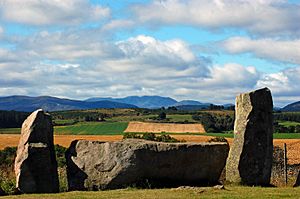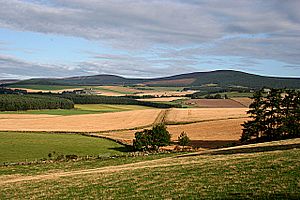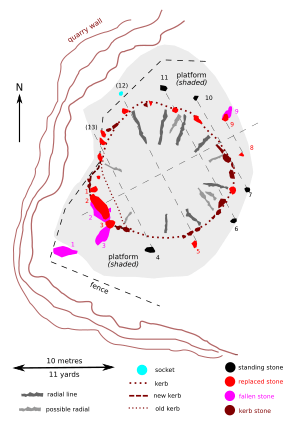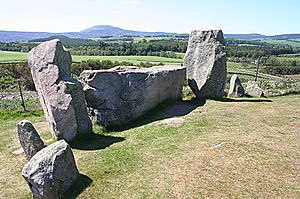Tomnaverie stone circle facts for kids
The Tomnaverie stone circle is an ancient stone circle in northeast Scotland. People built it around 2500 BC, during the Bronze Age. It has thirteen large granite stones, including a huge 6.5-ton stone lying on its side. This special stone is called a "recumbent stone." Inside the 17-meter wide circle, there was once a low 15-meter ring cairn (a pile of stones), but it is gone now.
By 1930, Tomnaverie was in bad shape. A nearby quarry had damaged it. Only four stones were still standing, and many were missing. The government took over the site in 1930, which stopped more damage. In 1999, archaeologists started digging to learn how the circle was built. They also wanted to fix it as much as possible. This project was very successful! Now, only two standing stones are missing.
The digging showed that the cairn was built first. It seems it was made to prepare the ground for the stone circle. This was a surprise, as experts thought the circle came first. This new idea makes it less likely that people used the circle for watching the stars.
Contents
What are Recumbent Stone Circles?
A recumbent stone circle is a special type of stone circle from the early Bronze Age. Its main feature is a very large stone, called the recumbent stone. This stone always lies flat. It is usually placed on the south or southwest side of the circle. Two tall "flanker stones" stand on each side of the recumbent stone. These are often the tallest stones in the whole circle. The smallest stones are usually on the northeast side.
The rest of the circle has about six to ten other standing stones. They get smaller as they go around the circle. Builders often chose flat hilltops for these circles. These spots had great views of other important places. More than seventy of these circles are found in Aberdeenshire, Scotland. Similar circles are found in southwest Ireland. Recumbent stone circles usually had a low ring cairn inside. Many of these cairns have disappeared over time. We don't know exactly why these circles were built. Sometimes, burnt human bones have been found at these sites.
This stone circle sits on a small hill. It is about 1 kilometer south of Tarland in Aberdeenshire. There is a car park for visitors. From there, it's a short walk uphill to see the stones. The hill is 178 meters high and made of granite. The area is called the Howe of Cromar. It is surrounded by hills and mountains. Famous ones include Lochnagar, about 30 kilometers away, and Morven.
The circle is 17 meters wide. The recumbent stone and its two flankers face southwest. The recumbent stone is a huge granite block. It is 3.2 meters long, 1 meter thick, and 1.15 meters high. It weighs 6.5 tons! This stone has a lighter color than the others. It also has two small "cup marks" carved into it. One is on top, and the other is on its outer side.
The eastern flanker stone is 1.80 meters tall and weighs 2.5 tons. The western flanker is 1.9 meters tall and weighs 3.5 tons. Originally, there were ten other stones in the circle. Two of these, on the northwest side, are now missing. One stone on the southeast side is light grey. The other stones and flankers are pale red. The stones get shorter as you move away from the flankers. The spaces between them also get smaller. The shortest stone is on the north-northeast side. It looks like its top might have broken off.
The circle was built on a platform of stones. This platform is up to 24 meters wide and 0.6 meters high. On top of this, there was a 15-meter wide cairn. It had a granite kerb (a border of slabs and blocks). In the southwest, the kerb turns outwards. It connects with the sides of the recumbent stone setting.
Before the 1999 Dig
Over many years, the stone circle slowly fell apart. The nearby quarry caused a lot of damage. The quarry wall was right next to the west side of the circle. Workers might have pushed the huge recumbent stone over. They may have done this to stop it from falling into the quarry. Both flanker stones had fallen outwards from the circle. The western one had even slid down into the quarry. There were still signs of the ring cairn, but the center was empty.
The Archaeological Dig
Archaeologists dug at Tomnaverie in 1999 and 2000. They wanted to learn the history of the circle. They also wanted to figure out how to show it to the public. They started by making a detailed map using photos.
When they removed the grass and topsoil, they found the inside of the circle was better preserved than expected. The dig showed that the hilltop was first used for pyres (fires for burning things). This created a mound of burnt material, including human bones. Later, this mound was surrounded by rocks. This formed the cairn. The rocks were also spread out to make a flat platform on the hill.
The archaeologists found that the cairn was a hollow ring. It had an empty space in the middle. They found an outer kerb that was once all around the cairn. Seven lines of boulders were found inside the cairn. They looked like spokes dividing it into sections. Where the ground sloped steeply, terraces were built. These helped the cairn extend outwards. This prepared the area for the recumbent stone.
Near the northeast side, they found pieces of Beaker pottery. They also found charcoal under the cairn. This charcoal was dated to about 2500–2450 BC. This confirms the circle is from the early Bronze Age. They also found pieces of later Bronze Age pottery and stone tools. These included six flint blades. Not many signs of people living right near the circle were found. However, by the Bronze Age, the area was being farmed. Archaeologists also found 29 rocks with cup marks nearby.
After the cairn was built, the stone circle was added. The cairn and platform were clearly designed for the circle. The lines of boulders laid down earlier seemed to point to where the standing stones would go. The recumbent stone was placed in a shallow dip. It was held in place with smaller stones. The other standing stones were lowered into holes dug into the platform. At the same time, the cairn's kerb was changed. It was made to connect with the flanker stones. Some large kerb stones inside the circle were removed. The standing stones seem to have been placed in pairs. They faced each other at right angles to the recumbent stone.
After the circle was built, not much happened until around 1000 BC. Then, more burnt bone fragments were found. In the 16th or 17th century AD, a pit was dug in the middle of the cairn. More burnt bones were found there too.
Putting it Back Together

The archaeologists found the holes for four missing standing stones. One stone was found buried next to its hole. Another was found in the quarry itself. This stone had fallen before 1870 but was found unbroken in 1999. These three stones, and the two flankers, were lifted by a crane. They were put back into their original holes. The stone on the west side could not be found. The huge recumbent stone was also turned and lifted back into place by a crane. It was perfectly level again.
In 2003, part of the quarry was filled in. The area was made to look natural again. Now, when you look across the circle, the recumbent stone points to the mountain Lochnagar. It is also where the full moon sets at midsummer during a "minor lunar standstill."
What We Learned from the Dig
The dig showed that the Tomnaverie stone circle was built around 2500 BC. This was thought to be true before, but now it is certain. What was surprising was that the stone circle was built *after* the cairn. The builders planned the circle when they built the cairn. Some theories suggested people gathered inside the circle to watch the stars. This now seems unlikely. Other digs at similar stone circles have found the same building order.
It is still unclear if the building stages happened quickly or over many years. It also seems the monument was not mainly for burials.
Some experts thought these circles were for watching astronomical events from inside. Since people thought the cairns were built later, there would have been space inside. But now we know the cairn was built first. This makes it "difficult, if not impossible," to watch the moon from inside the circle. The idea that the circle points to Lochnagar is still there. However, one expert notes that the recumbent stone blocks the view of the mountain from the opposite side of the circle.
|





